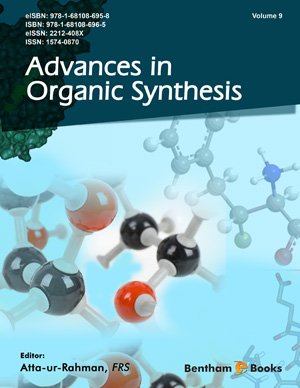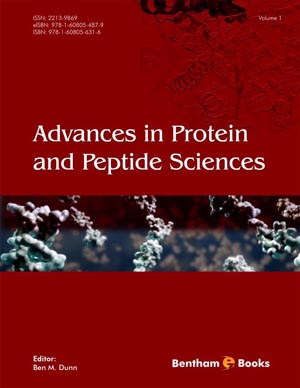Book Volume 9
Asymmetric Hydrogenation of Tetrasubstituted Olefins
Page: 1-24 (24)
Author: Kristen Ryan and Robert B. Kargbo
DOI: 10.2174/9781681086958118090003
PDF Price: $30
Abstract
The asymmetric hydrogenation of tetrasubstituted olefins has been one of the most formidable challenges in the reduction of olefins. While the reduction of diand tri-substituted olefins has grown at a rapid pace, the reduction of tetrasubstituted olefins has grown at a much slower rate. However, there have been a number of pivotal breakthroughs, from the reports of Zhou and Buchwald to the advent of the discovery of the chiral phosphoramidite ligands. In addition, high throughput experimentation has been very beneficial in the discovery of rapid and useful reaction conditions to affect remarkable selectivities. This led to the discovery of rhodium-Josiphos based catalysts, which have been frequently used in the asymmetric reduction of tetrasubstituted olefins.
Recent Advances in Catalytic Organic Synthesis Applications of Covalently Supported Ionic Liquids
Page: 25-71 (47)
Author: Yu Lin Hu
DOI: 10.2174/9781681086958118090004
PDF Price: $30
Abstract
Supported ionic liquids have attracted increasing attentions in the area of organic synthesis due to their significant properties including good chemical and thermal stability, wide liquid temperature range, considerable ionic conductivity, nonflammability, and high surface area with a remarkable level of catalytic performance. Moreover, due to their heterogeneous properties, they have the attractive features of easy separation and recyclability. This review covers recent studies on the applications of supported ILs as green catalysts for the traditional reagents in catalytic organic synthesis such as condensation reaction, oxidation, coupling reactions as well as some other reactions. The adaptabilities of supported ILs in these reactions are predicted as a solution to the problems of conventional chemical processes and to become a powerful method in organic synthesis.
Recent Developments in Intramolecular Cyclization Reactions via Carbon-heteroatom (CX) Bond Formation
Page: 72-120 (49)
Author: Vishu Mehra, Isha Lumb and Vipan Kumar
DOI: 10.2174/9781681086958118090005
PDF Price: $30
Abstract
The overwhelming potential of heterocyclic compounds in pharmaceutical sector continuously demands the development of new synthetic approaches. The beginning of 19th century witnessed an era of development of various condensation reactions for the development of new heterocyclic scaffolds. Most of the developed classical reactions still hold great value while the field is inundated in 21st century with the advent of catalysis. The activation of unsaturated functionalities of acyclic compounds to undergo intramolecular cyclization via metal catalyzed approaches or the transformation of azetidin-2-ones to functionally enriched compounds have occupied a prominent place in heterocyclic synthesis.
Efficient Synthetic Protocol and Mechanistic Study of Quinazoline Analogues and their Biological Importance
Page: 121-146 (26)
Author: Sumit Kumar Panja and Satyen Saha
DOI: 10.2174/9781681086958118090006
PDF Price: $30
Abstract
Our main focus is on the recent developments for the synthesis of highly functionalized quinazoline derivatives in terms of an efficient, one-pot, eco-friendly, solvent-free, high yield, cost-effective, multicomponent strategy with the variation of substrates and catalytic conditions. Further, we have also emphasized on the mechanistic studies depending upon variation of substrates. Detailed mechanistic aspects have been established based on isolated intermediates and their single crystal X-ray structures. The biological importance of selected small quinazoline derivatives has been highlighted as well. In particular, we have observed that selected quinazolinebased small molecules show global upregulation of miRNA expression with a selective enrichment of tumor suppressor miRNAs. Therefore, quinazolines can be used as scaffolds to design activator of miRNA expression, thus paving the way for the development of novel anti-cancer drugs.
Synthesis of N,O,S-Heterocycles by One-Pot Reactions of Epoxides, Aziridines and Oxaziridines
Page: 147-248 (102)
Author: Oleksandr Zhurakovskyi and Vitalii Palchykov
DOI: 10.2174/9781681086958118090007
PDF Price: $30
Abstract
Discovery of new effective methods for the synthesis of aziridines, epoxides and oxaziridines, as well as development of novel transformations of these heterocycles, has been an extremely active area of research in recent years. In just two or three steps, these small heterocycles can be converted into a vast array of four-toseven- membered rings and open-chain compounds. The diversity of possible transformations transpired in a torrent of publications, with hundreds of papers published every year. This review covers recent (2007 to the end of 2017) literature on one-pot transformations of aziridines, epoxides, and oxaziridines. Within this, deceptively narrow, topic there is a great number of synthetically useful or mechanistically interesting reactions leading to diverse families of N,O,S-heterocycles, including thiiranes, oxetanes, azetidines, azetidinones, furans, 1,3-oxazolines, 1,3- oxazolidines, 1,3-oxazolidin-2-ones, 1,3-thiazolidines, imidazoles, 1,2,3-triazoles, pyrans, 1,4-oxazines (morpholines), azepanes, oxazepanes etc. The review aims to give the readers an insight into the great practical utility of epoxides, aziridines and oxaziridines. It presents the most modern methods for their expedited conversion into a broad range of heterocycles.
Introduction
Advances in Organic Synthesis is a book series devoted to the latest advances in synthetic approaches towards challenging structures. The series presents comprehensive reviews written by eminent authorities on different synthetic approaches to selected target molecules and new methods developed to achieve specific synthetic transformations or optimal product yields. Advances in Organic Synthesis is essential for all organic chemists in academia and the industry who wish to keep abreast of rapid and important developments in the field. This volume presents the following reviews: • Asymmetric hydrogenation of tetrasubstituted olefins • Recent advances in catalytic organic synthesis applications of covalently supported ionic liquids • Recent developments in intramolecular cyclization reactions via carbon-heteroatom (c-x) bond formation • Efficient synthetic protocol and mechanistic study of quinazoline analogues and their biological importance • Synthesis of N,O,S-heterocycles by one-pot reactions of epoxides, aziridines and oxaziridines






















